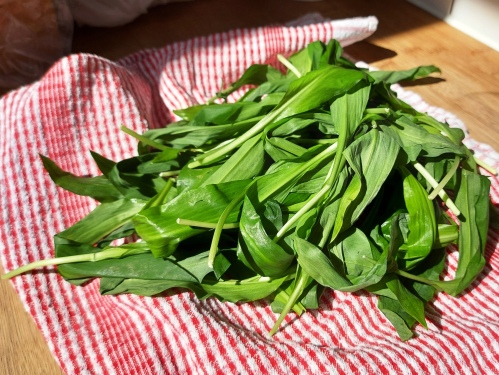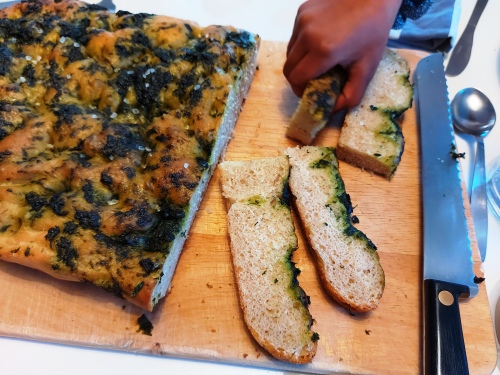This past month the weather has gone from cold (the end of winter), to unseasonably warm (a dash of climate change), to cold again, to just about normal for the time of year. Spring. It is definitely spring. The view from my kitchen sink has turned into a wall of fresh green and red, the latter the leaves of an ornamental cherry. The lawn needs cutting, other than the increasingly large area I’m converting into a wildlife friendly wildflower patch, and it’s dotted with dandelions. It’s very green, as only new growth can be.
There’s a very distinct type of middle-aged man here in Britain who obsesses over his lawns – feeding them, blasting them with chemicals, mowing them into neat stripes. I like some neatness, but the favourite part of my garden these days is the unruly wildflower patch. By June it’ll be full of flowering weeds – wild carrot, salad burnet, wild oregano, greater knapweed, red clover, little daisies, giant daisies, yarrow, fleabane, and many many more (I reckon there are 30-plus species in there now). But now it’s mostly about the dandelions. Some wildlife gardening experts recommend you leave them because, as they flower early, they’re an invaluable food for bees. I struggle a bit with this, as if you like a wildflower patch, dandelions can also take over a bit, spreading their seeds effortlessly, their wide leaf crowns out-competing other species.
So they take a bit of management. Not with toxins, but the occasional digging out. And eating. I’ve just used some of their leaves in this quiche, along with herbs foraged on a walk on Easter Monday. It was one of our favourites routes, taking in Knowlands Wood*, a private wood in East Sussex whose owners allow (respectful) access, which at this time of year is carpeted with wood anemones (Anemonoides nemorosa) and native bluebells (Hyacinthoides non-scripta, not the introduced Hyacinthoides hispanica, which takes over parts of my garden). Then heading for the Spithurst Hub café, with its wonderful selection of Swedish treats – cinnamon, cardamom and vanilla rolls. Love that fika action. Walking back, we even saw our first orchids of the season on an old railway embankment, early purples (Orchis mascula, not edible and not to be picked!).
My friend Alex “Kabak” Marcovitch gets fairly obsessive about the foraging at this time of year, notably going for hogweed (Heracleum sphondylium) shoots. I went for your basic wild garlic (Allium ursinum), which is very easy to over-pick, and indeed I’m still using up a roll of wild garlic butter I made last year and froze, as well as jack-by-the-hedge aka garlic mustard (Alliaria petiolata).
When you get your foraged wild herbs there’s always a question of what to do with them. I’d recently noticed I had leftovers of four different types of pastry in the freezer – hot water crust, almond pastry, puff pastry and cream cheese pastry, from a great pie crust recipe by Dan Lepard. I used some of them in an excellent recipe for oat biscuits, which I will share on here at some point. But for the herbs, I decided to make a quiche or pie, using up the cream cheese pastry. I’m not going to give a recipe here for the quiche as it was pretty freeform but here’s Dan pastry.
These quantities make about 750g, which is quite a lot, hence I had some left in the freezer. You’ll need a food processor with a decent capacity. This makes life a lot easier, though you can make it by hand too.
400g plain flour
1/2 teaspoon baking powder
1/4 teaspoon fine salt
150g unsalted butter, chilled and cut into cubes
150g full-fat cream cheese
1 egg, beaten
1. Simply combine everything except the egg in a food processor and process until uniform. Alternatively, sieve the dry ingredients into a bowl then rub in the butter and cream cheese.
2. Add the egg and bring to a dough, kneading – but not overkneading – until smooth.
3. Wrap and chill in the fridge, or freeze, until you need it.
So, quiche. I’ve never much liked quiche. As a vegetarian throughout the nineties and noughties, I was often faced with quiche. Never a nice, homemade quiche, but a deeply dodgy supermarket-industrial quiche that was offered to me as the vegetarian option by people who couldn’t even begin to handle meat-free cooking. Times have changed a lot since then, with the huge rise in vegetarianism and veganism recently, though I expect the supermarkets still sell the same vile quiche, which always seemed to taste just eggy. I know egg is essential for quiche, but the whole idea is you can pack them with flavour to the point where the egg is mainly a binder – not the overall flavour, especially not that that nasty caricature of egg flavour found in industrial food.
Here, I sautéed down a finely sliced onion in some wild garlic butter and oil, added loads of black pepper and a good pinch of ground up dried chillies (the last of last year’s crop) and briefly wilted down the coarsely shredded weeds – about three large handfuls of the garlic, jack and dandelions leaves. Stinging nettles (Urtica dioica) would also be good, but the usual patch in my garden hasn’t appeared this year and I forgot to grab any on our walk. Then I beat three eggs and added some chunks of feta and hard goats cheese, as well as a nice teaspoon or so or za’atar. As I said – somewhat freeform. Combine the egg mix with the weed mix.
Meanwhile, I’d rolled the pastry to about 5mm and lined a flan tin. I pricked the bottom, then baked this blind for about 25 minutes in a 180C oven. When the pastry was slightly browned, I took it out then added the filling, and baked it for another 20 minutes or so, until nicely browned. Garnish with any wild spare wild herb flowers or dandelion petals, and enjoy with a salad.
* If you want to visit Knowlands Wood in East Sussex, not far from the county town of Lewes, this What Three Words is right in the middle. We tend to park in a layby outside Holmansbridge Farm Shop and pick up the public footpath there. It’ll lead you towards the woods, either across a field or via an old railway embankment,, forking around a sewerage works. Otherwise, head to the Spithurst Hub and follow the permissive paths from there, initially along a track into fields populated by ewes and newborn lambs at this time of year. The owners of Knowlands, Nick and Harriet Lear, have managed the 30 hectare woods since the early 1980s as a private nature reserve and their work is really paying off. The birdsong – including nightingale if you’re there at the right time in spring – and butterflies are testament to this.












